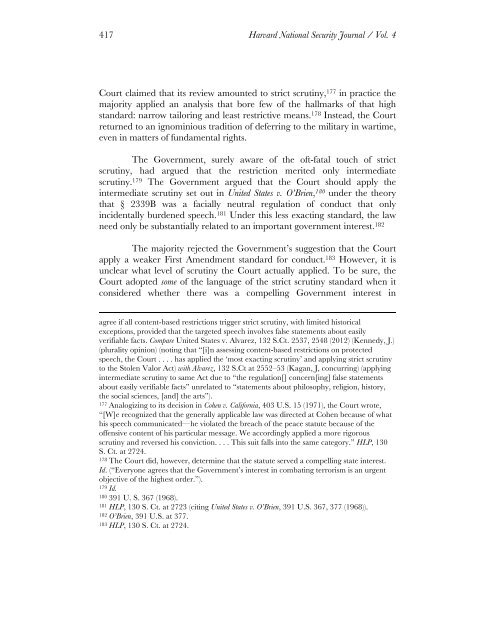Vo.4-Moshirnia-Final
Vo.4-Moshirnia-Final
Vo.4-Moshirnia-Final
Create successful ePaper yourself
Turn your PDF publications into a flip-book with our unique Google optimized e-Paper software.
417 Harvard National Security Journal / Vol. 4<br />
Court claimed that its review amounted to strict scrutiny, 177 in practice the<br />
majority applied an analysis that bore few of the hallmarks of that high<br />
standard: narrow tailoring and least restrictive means. 178 Instead, the Court<br />
returned to an ignominious tradition of deferring to the military in wartime,<br />
even in matters of fundamental rights.<br />
The Government, surely aware of the oft-fatal touch of strict<br />
scrutiny, had argued that the restriction merited only intermediate<br />
scrutiny. 179 The Government argued that the Court should apply the<br />
intermediate scrutiny set out in United States v. O’Brien, 180 under the theory<br />
that § 2339B was a facially neutral regulation of conduct that only<br />
incidentally burdened speech. 181 Under this less exacting standard, the law<br />
need only be substantially related to an important government interest. 182<br />
The majority rejected the Government’s suggestion that the Court<br />
apply a weaker First Amendment standard for conduct. 183 However, it is<br />
unclear what level of scrutiny the Court actually applied. To be sure, the<br />
Court adopted some of the language of the strict scrutiny standard when it<br />
considered whether there was a compelling Government interest in<br />
agree if all content-based restrictions trigger strict scrutiny, with limited historical<br />
exceptions, provided that the targeted speech involves false statements about easily<br />
verifiable facts. Compare United States v. Alvarez, 132 S.Ct. 2537, 2548 (2012) (Kennedy, J.)<br />
(plurality opinion) (noting that “[i]n assessing content-based restrictions on protected<br />
speech, the Court . . . . has applied the ‘most exacting scrutiny’ and applying strict scrutiny<br />
to the Stolen Valor Act) with Alvarez, 132 S.Ct at 2552–53 (Kagan, J, concurring) (applying<br />
intermediate scrutiny to same Act due to “the regulation[] concern[ing] false statements<br />
about easily verifiable facts” unrelated to “statements about philosophy, religion, history,<br />
the social sciences, [and] the arts”).<br />
177 Analogizing to its decision in Cohen v. California, 403 U.S. 15 (1971), the Court wrote,<br />
“[W]e recognized that the generally applicable law was directed at Cohen because of what<br />
his speech communicated—he violated the breach of the peace statute because of the<br />
offensive content of his particular message. We accordingly applied a more rigorous<br />
scrutiny and reversed his conviction. . . . This suit falls into the same category.” HLP, 130<br />
S. Ct. at 2724.<br />
178 The Court did, however, determine that the statute served a compelling state interest.<br />
Id. (“Everyone agrees that the Government’s interest in combating terrorism is an urgent<br />
objective of the highest order.”).<br />
179 Id.<br />
180 391 U. S. 367 (1968).<br />
181 HLP, 130 S. Ct. at 2723 (citing United States v. O’Brien, 391 U.S. 367, 377 (1968)).<br />
182 O’Brien, 391 U.S. at 377.<br />
183 HLP, 130 S. Ct. at 2724.
















